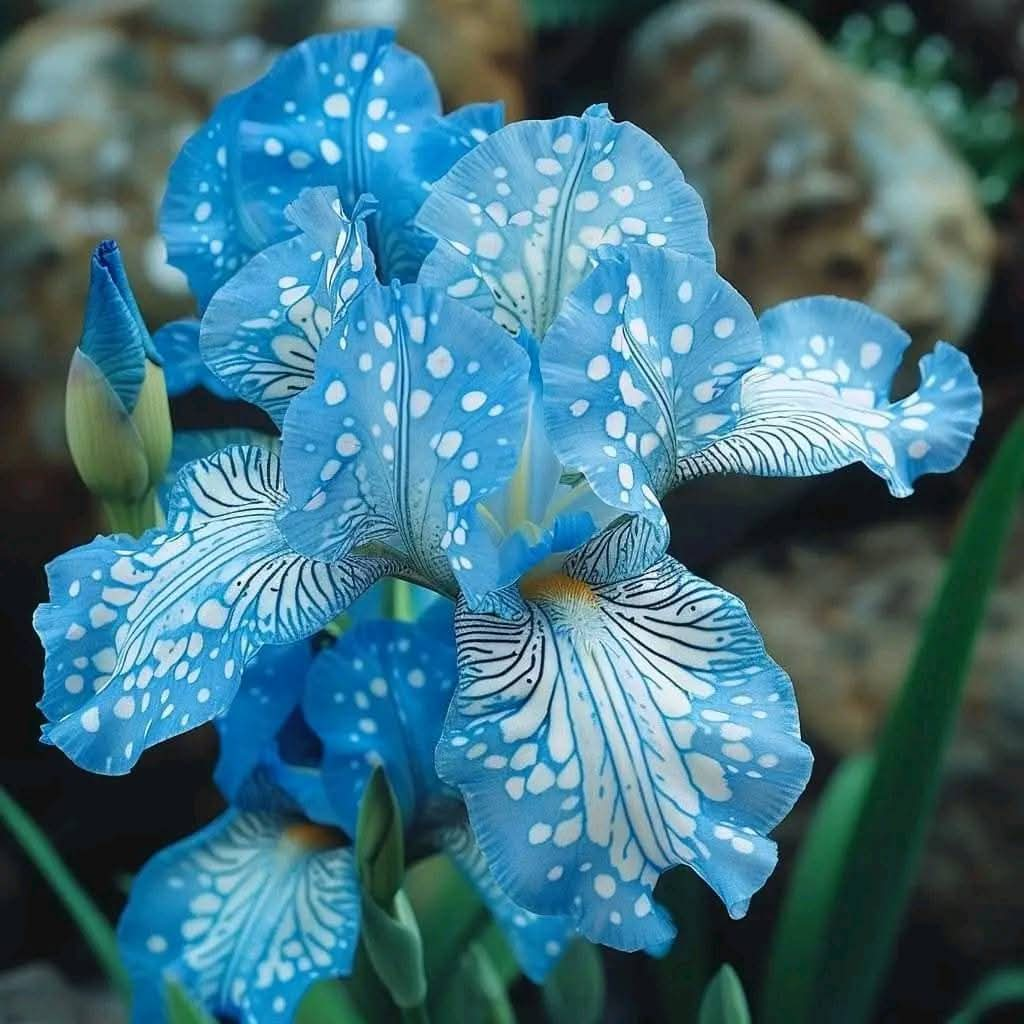The Blue Bearded Iris is a breathtaking flower that enchants gardeners with its vibrant blue petals, delicately streaked with intricate white patterns. This hardy, drought-tolerant beauty brings a touch of timeless elegance to any garden while requiring surprisingly low maintenance. If you’re looking for a show-stopping bloom that thrives in various conditions, the Blue Bearded Iris is the perfect choice!
Why This Flower Stands Out
The Blue Bearded Iris is celebrated for its unique “beard” — a fuzzy, caterpillar-like ridge on the lower petals, which guides pollinators to the flower’s center. The combination of vivid blue hues and crisp white markings makes it a striking addition to garden beds, borders, or floral arrangements. These blooms not only offer visual appeal but also symbolize wisdom, hope, and faith, adding deeper meaning to their beauty.
What You’ll Need to Grow the Blue Bearded Iris
Light: Full sun (at least 6 hours of direct sunlight per day). Partial shade is tolerated, but full sun encourages the most abundant blooms.
Temperature: Thrives in 10°C to 25°C (50°F to 77°F). It’s a hardy plant that can tolerate brief temperature extremes, making it versatile for various climates.
Soil: Well-drained, fertile soil. Irises dislike soggy roots, so sandy or loamy soil with good drainage is ideal.
Water: Moderate watering. Allow the soil to dry slightly between waterings. Established irises are drought-tolerant, making them perfect for water-wise gardens.
Fertilizer: Feed with a low-nitrogen, phosphorus-rich fertilizer in early spring and again after blooming to promote healthy growth and strong flowers.
How to Plant and Care for Your Iris
- Planting the Rhizomes:
Plant iris rhizomes in late summer or early fall for spring blooms.
Position the rhizome just below the soil surface, with the top slightly exposed. Space plants 12–18 inches apart to allow airflow and prevent overcrowding.
- Watering & Mulching:
Water deeply after planting, then reduce watering as the plant establishes. Once mature, the iris only needs supplemental water during prolonged dry spells.
Avoid heavy mulching over the rhizome, as it can trap moisture and cause rot.
- Deadheading & Pruning:
Remove spent blooms to encourage more flowers and prevent seed formation.
In late fall, trim back the foliage to about 6 inches to reduce pests and prepare the plant for winter.
- Dividing the Rhizomes:
Divide clumps every 3–4 years to prevent overcrowding and maintain vigorous flowering.
Lift the rhizomes, trim the leaves, and replant the healthiest sections in freshly amended soil.
Why Grow a Blue Bearded Iris?
The Blue Bearded Iris offers an irresistible blend of beauty and resilience. Its vibrant blooms add a burst of color to gardens, while its hardy nature makes it a low-maintenance choice for both beginner and seasoned gardeners. Whether lining a garden path, brightening up a flower bed, or starring in a floral bouquet, this iris never fails to impress.
Plus, their drought tolerance and adaptability make them a sustainable option for eco-conscious gardeners. You get the best of both worlds: a dramatic, eye-catching bloom with minimal fuss!
Final Thoughts
If you’re looking to infuse your garden with vibrant hues, intricate patterns, and a touch of magic, the Blue Bearded Iris is an unbeatable choice. It’s a flower that rewards you with years of dazzling blooms, requires minimal upkeep, and adds a sense of elegance that few plants can match.
More Articles You Might Like
-
Texas Toast Sloppy Joes: The Crunchy, Cheesy Upgrade You Didn’t Know You Needed
There’s something timeless about sloppy joes. For generations, this saucy, savory, and slightly sweet ground beef sandwich has been a go-to comfort food in American kitchens. It’s quick, filling, and family-friendly—perfect for busy weeknights. But what if we told you there’s a way to take this classic dish up a notch? Enter the Texas Toast…
-
Classic Pig Pickin’ Cake
When it comes to Southern desserts, few sweets shine as brightly as the Classic Pig Pickin’ Cake. This nostalgic cake, sometimes called a “Mandarin Orange Cake,” has roots deep in Southern tradition. It gets its playful name from its frequent appearance at pig pickin’s—Southern-style barbecue gatherings where communities come together to enjoy slow-cooked pork, sides,…
-
Lemon Garlic Butter Chicken with Creamy Parmesan Pasta
There’s something irresistible about the combination of tender, golden-browned chicken paired with a creamy pasta coated in Parmesan cheese. Add the brightness of lemon, the depth of garlic, and the richness of butter, and you have a recipe that feels indulgent yet approachable enough for a weeknight dinner. Lemon Garlic Butter Chicken with Creamy Parmesan…



